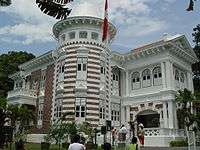Chinese revolutionary activities in Malaya

Sun Yat-sen along with Tong Meng Hui were not all that successful in holding revolutionary activities in Malaya, which consists of present-day Peninsular Malaysia and Singapore. The British colonial government maintained diplomatic relations with the Qing Government from the point of view of national relations, and the Qing embassies in Singapore and Penang became obstructions for the revolutionary activities. On the other side, the diplomats of the Qing Government visited areas of Malaya, and were welcomed by the local Chinese residents. These diplomats lobbied for local Chinese loyalty to the Qing Government; some of them sold government positions to achieve these goals. Hu Hanmin described the Chinese in the Southeast Asia as "Anyone that had some sort of official positions under the Manchus can go to Southeast Asia and bluff, saying "The three generations of my family were all first-grade officials, and I'm also a significant official with luxurious government headgear!", and these bluffs will create a sensation in the local Chinese to adore you. From Hu Hanmin's description, it is apparent that the Chinese in Malaya were still influenced by conservative ideas. These conservative ideas helped the royalists led by Kang Youwei to win responses from the local Chinese residents.
The royalists led by Kang Youwei and the revolutionaries led by Sun Yat-sen were vastly different in the idea of establishing a new system of applying remittance, and because of this, these two parties had a large-scale debate on the converge of remittance in Southeast Asia. The royalists and the revolutionaries both had their own papers, and on their paper was surrounded by intense debates on the topics of constitutional monarchy and democratic revolution. In these debates, the local upper class Chinese were the supporters of the royalists, as they wanted their fortune to remain unaffected, and supported the royalists to protect their own interest. The lower class such as store clerks, merchants, miners and other civilians were the supporters of the revolutionaries. The debates first began in Singapore, and the papers that supported the royalists included "Xin Bao" and "Tian Nan Xin Bao" while the revolutionaries had the support of "Zhong Xing Daily" and "Zhong Hui Xin Bao". In Malaya, Huang Jinqing established "Penang Daily" in 1906, and it became the first paper of the revolutionaries in Penang.
Sun Yat-sen made Penang the headquarters of the Nanyang Tongmenghui from 1909 to 1911. Among his most important supporters in Penang were Wu Shirong (Goh Say Eng), Huang Jingqing (Ng Kim Kheng) and Chen Xinzheng (Tan Sing Cheng). At this time, the Penang chapter of the Tongmenghui was the most active in Malaya, organising many activities under the cover of the Penang Philomatic Union at 120 Armenian Street (now the Sun Yat Sen Museum Penang). Sun Yat-sen convened the 1910 Penang Conference to plan the Second Guangzhou Uprising, the most important event organised by the Tongmenghui. On 10 December 1910, Sun Yat-sen, Chen Xinzheng and Zhuang Yinan established Guang Hua Daily (Kwong Wah Yit Poh). Guang Hua Daily was not only an important apparatus paper of the revolutionaries in Malaya, and became the longest running paper in Malaysian newspaper history and Chinese newspaper history around the world. The meaning of Guang Hua is "To restore China", and was approved by Sun Yat-sen himself.